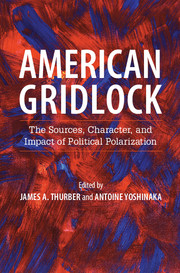Book contents
- Frontmatter
- Dedication
- Contents
- List of contributors
- Foreword
- Acknowledgments
- Introduction
- PART I POLARIZATION AMONG VOTERS AND ACTIVISTS
- PART II POLARIZATION IN NATIONAL INSTITUTIONS
- PART III POLARIZATION IN THE STATES
- 9 Polarization in American State Legislatures
- 10 The Costs of Party Reform: Two States’ Experiences
- 11 The Policy Consequences of Party Polarization: Evidence from the American States
- PART IV POLARIZATION IN THE MEDIA
- PART V IMPLICATIONS AND CONCLUSIONS
- Index
- References
9 - Polarization in American State Legislatures
from PART III - POLARIZATION IN THE STATES
Published online by Cambridge University Press: 05 November 2015
- Frontmatter
- Dedication
- Contents
- List of contributors
- Foreword
- Acknowledgments
- Introduction
- PART I POLARIZATION AMONG VOTERS AND ACTIVISTS
- PART II POLARIZATION IN NATIONAL INSTITUTIONS
- PART III POLARIZATION IN THE STATES
- 9 Polarization in American State Legislatures
- 10 The Costs of Party Reform: Two States’ Experiences
- 11 The Policy Consequences of Party Polarization: Evidence from the American States
- PART IV POLARIZATION IN THE MEDIA
- PART V IMPLICATIONS AND CONCLUSIONS
- Index
- References
Summary
• New measures of state legislative polarization show that Democrats and Republicans continue to diverge, although more quickly in some states than in others. Levels of polarization in many states exceed that of Congress.
• No one “smoking gun” explains state legislative polarization. In many cases, we can only rule out suspected causes such as primaries. However, interesting new evidence implicates specific forms of opinion polarization and income inequality.
• The consequences of state legislative polarization are only now beginning to be explored. Increasing unilateralism by governors appears to be one major implication of increased gridlock within the legislature.
• Major advances in our understanding of polarization are more likely to come from the states compared with Congress, given the tremendous institutional and preference variation in the former compared with the latter
INTRODUCTION
Most of the recent scholarly literature on Congress emphasizes trends that indicate rising party differences in roll call voting behavior (Poole and Rosenthal 1997; McCarty, Poole and Rosenthal 2006). These findings are generally based on measures of positions on the liberal-conservative continuum as revealed through roll call voting. Although various techniques for measuring the ideology of legislators have been developed, they all produce very similar findings. The measure of polarization I use in this chapter is the difference in medians between Democrats and Republicans, with a larger gap indicating a greater level of polarization.
Why do we care about polarization? Excessive levels of partisanship and ideological polarization have been shown to have a pernicious effect on many aspects of policymaking and governance (see McCarty, Poole, and Rosenthal 2006, 2013, and Barber and McCarty 2015 for a review of the evidence at the national level). As recent events in many state capitols attest, these problems are beginning to afflict policymaking at the state level. As a result, a robust public debate about how to reduce polarization and partisanship has emerged.
What about American state legislatures? Are they polarizing like Congress? It is important to quantify such trends because we want to know if polarization is leading to political gridlock and dysfunctional policy. We also need a barometer of polarization to find out whether institutional reforms such as opening up primaries, taking redistricting away from politicians themselves, setting term limits, and so forth can ameliorate this phenomenon.
- Type
- Chapter
- Information
- American GridlockThe Sources, Character, and Impact of Political Polarization, pp. 203 - 221Publisher: Cambridge University PressPrint publication year: 2015
References
- 21
- Cited by



